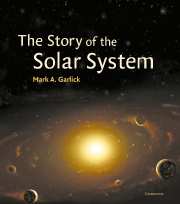Book contents
- Frontmatter
- Contents
- Miscellaneous Frontmatter
- Introduction
- Part 1 Genesis of the Sun and Solar Nebula
- Time zero: Giant Molecular Cloud
- 2 000 000 years: Solar Globule
- 2 030 000 years: Protosun
- 2 130 000 years: Solar Nebula
- 3 million years: T-Tauri Phase
- 3 million years: Outflow and Post-T-Tauri Phase
- 30–50 million years: The Main Sequence
- Part 2 Emergence of the Sun's Family
- Part 3 Solar System Past and Present
- Part 4 End of an Era
- Glossary
- Index
2 000 000 years: Solar Globule
from Part 1 - Genesis of the Sun and Solar Nebula
Published online by Cambridge University Press: 10 November 2009
- Frontmatter
- Contents
- Miscellaneous Frontmatter
- Introduction
- Part 1 Genesis of the Sun and Solar Nebula
- Time zero: Giant Molecular Cloud
- 2 000 000 years: Solar Globule
- 2 030 000 years: Protosun
- 2 130 000 years: Solar Nebula
- 3 million years: T-Tauri Phase
- 3 million years: Outflow and Post-T-Tauri Phase
- 30–50 million years: The Main Sequence
- Part 2 Emergence of the Sun's Family
- Part 3 Solar System Past and Present
- Part 4 End of an Era
- Glossary
- Index
Summary
Once the collapse of the giant molecular cloud had started, it continued under its own momentum. By the time two million years had passed, a multitude of nuclei had developed in the cloud, regions where the density was higher than average. These concentrations began to pull in more gas from their surroundings by virtue of their stronger gravity, and the original cloud fragmented into hundreds or even thousands of small, dense cores. Most of them would later form stars. One of them was destined to become the Sun.
By now, the cloud core from which the Sun would form was perhaps a tenth of a light-year across, more than a hundred times the present size of the Solar System out to Pluto. Gradually, this tight clump of gas continued to fall in on itself like a slow-motion demolished chimney stack, a process known as gravitational freefall. The innermost regions fell the fastest; they were closest to the central condensation where the gravitational pull was greatest. The outermost edges of the cloud core took longer to succumb to their inevitable fall. Thus, because of these differences in infall rates, the cloud's contraction essentially amounted to an implosion, an explosion in reverse. In time, as the gas closest to the centre plunged inward and accelerated, the material there grew steadily hotter, the atoms and molecules within it rubbing against each other frantically. After perhaps millions of years in a deep freeze, the molecular cloud was finally warming up. The eventual result was a gas and dust cocoon: a shell of dark material surrounding a denser, warmer core. Such an object is known as a globule. It was the Sun's incubator.
- Type
- Chapter
- Information
- The Story of the Solar System , pp. 12 - 13Publisher: Cambridge University PressPrint publication year: 2002
- 2
- Cited by



